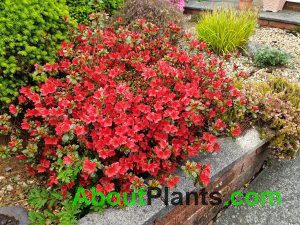The evergreen azalea is a very popular plant across Europe.
This plant belongs to the Ericaceae family (genus).
This means that these plants love acidic soils, much like their cousins the ericas and heathers, which belong to the same family.

Caring for Evergreen Azaleas
Evergreen azaleas can cope in quite poor soil conditions as long as they are well watered. The root systems do not survive well when allowed to dry out. They also like to be kept cool, which is an aspect of utmost importance because if they were exposed to warm conditions, they could dehydrate due to the root system’s close proximity to the soil surface. about the need for regular watering, as the roots stretch out near to the soil’s surface.

Evergreen Azalea’s Appearance
The evergreen azalea is a beautiful, vigorous plant that produces oval shaped leaves through all seasons and then in springtime produces a mass of exotic flowers which cover the whole bush. The leaves are usually deep green in colour, although there are varieties which produce variegated green and white striped leaves,which are more common in the annual azaleas (Azalea Mollis), which are not being dealt with in this article, but will feature on the. The flowers come in a variety of shades including reds, yellows, whites, pinks, purples and blues. The examples photographed here show varieties of red, pink and mauve flowers.

They can also be potted up in patio containers. Prior to planting, put the root system into a bucket of water for an hour or so to fully rehydrate the plant. Dig a hole large enough to accommodate the root system and then mix the soil that has been removed with about a third of lime based, ericaceous compost. Put a layer of organic compost at the bottom of the hole before putting the plant’s root system into the hole and topping up with the mixture of soil and lime rich, ericaceous compost. Azaleas do not need to be planted too deeply as the roots tend to stay near to the surface, which is why it’s so important to keep the root system cool with plenty of water all year round. When the plant has been positioned in the soil, tamp down gently and water well. If you have a chalky soil that is more alkaline rather than acidic, it is better to pot these plants in containers which can be better regulated. Remember to replenish the organic compost round the plants each spring to encourage healthy bushes and plenty of blossom.

When potted in containers, use an ericaceous compost which is peat or loam based. Repotting will be needed every couple of years and it is recommended that the top 3 inches are replaced with fresh compost in the years between repotting.
Rainwater is the most suitable for these plants, so ensure that they are not sheltered from the rain by larger plants or garden objects. Tap water can be used for the drier summer months. New evergreen azalea plants can be developed by taking a cutting from this year’s growth in late summer or early autumn when the shoots have completed the year’s growth and buds have started to form.

Plant these in plant pots with the same type of ericaceous compost as described above and keep well watered. There should not be many problems with evergreen azaleas especially if they have been well watered throughout the season and organic compost has been used to increase the potential for the plant to thrive successfully. Light pruning of deadwood and occasional deadheading of flowers is recommended, but other than that very little maintenance is required.
Height and Features of the Evergreen Azalea
Evergreen azaleas can achieve up to 2 m in height when fully mature, although the plants tend to be smaller when in pots. These plants must be planted in spring or autumn. These plants are excellent in rock gardens, in herbaceous borders, in the flower beds or in hedges. They are popular choices in Japanese style gardens.

These are beautiful plants which both provide joyous bundles of colour in the garden and increase insect life throughout the flowering period which can range from March and May. Flowers usually continue for three to six weeks depending on weather conditions. Windy weather will affect the duration of each plant’s flowering period as blossom will be lost in high winds.